This set of Zoology Multiple Choice Questions and Answers focuses on “Animal Tissues-2”.
1. The classification of glands is based on which of the following?
a) Mode of differentiation
b) Mode of pouring of secretions
c) Mode of cellular division
d) Number of cells
View Answer
Explanation: Glands are of mainly two types- exocrine and endocrine glands. These glands are divided on the basis of mode of pouring of their secretions. For example, if secretions are poured through the ducts then these are called exocrine glands and if secretions are poured directly into the blood then they are called endocrine glands.
2. Some of the squamous epithelial cells get specialised for the secretion and are called the glandular epithelium.
a) True
b) False
View Answer
Explanation: Some of the columnar or cuboidal cells get specialised for the secretion and are called as glandular epithelium. They are mainly of two types- unicellular glands and multicellular glands.
3. Which of the following structures does the given figure represent?
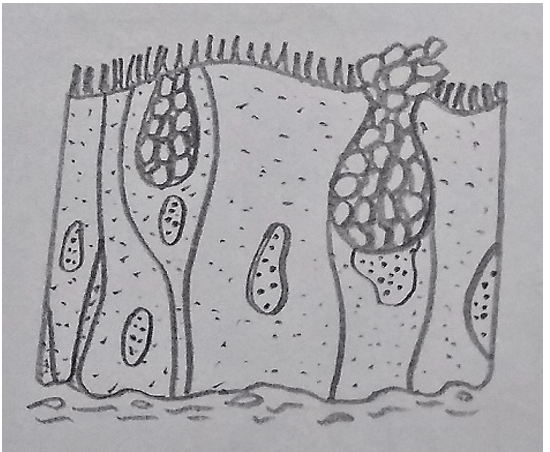
a) Multicellular gland
b) Endocrine gland
c) Exocrine gland
d) Unicellular gland
View Answer
Explanation: The given diagram represents unicellular gland. The unicellular gland consists of isolated glandular cells, for example, goblet cells of the alimentary canal which secrete mucus.
4. Which of the following structures does the given figure represent?
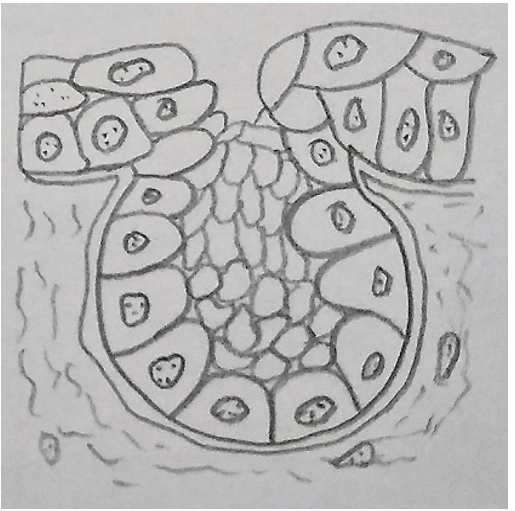
a) Multicellular gland
b) Compound epithelium
c) Squamous epithelium
d) Unicellular gland
View Answer
Explanation: The given diagram represents a multicellular gland. It consists of a cluster of cells, for example, the salivary gland. Most of the glands present in our body are multicellular glands.
5. Which of the following is not a secretion of exocrine glands?
a) Mucus
b) Saliva
c) Hormones
d) Ear wax
View Answer
Explanation: Exocrine gland secretes mucus, saliva, earwax, oil, milk, digestive enzymes and other cell products. Their products are released through ducts or tubes. In contrast, endocrine glands do not have ducts. Their products are called hormones and are secreted directly into the fluid bathing the gland.
6. Which of the following is an incorrect statement regarding compound epithelium?
a) The main function is secretion and absorption
b) Cover dry surface of the skin
c) Made of more than one layer of cells
d) Cover moist surface of the buccal cavity
View Answer
Explanation: Compound epithelium is made up of more than one layer of cells and thus has a limited role in secretion and absorption. Their main function is to protect against chemical and mechanical stresses. They cover the dry surface of the skin and also the moist surface of the buccal cavity.
7. Which of the following junctions help to stop substances from leaking against a tissue?
a) Adhering junctions
b) Gap junctions
c) Tight junctions
d) Loose junctions
View Answer
Explanation: In nearly all the animal tissues, specialised junctions provide both structural and functional links between its cells. Tight junctions help to stop substances from leaking across a tissue.
8. Which of the following is the most abundant and widely distributed tissue in the human body?
a) Muscular tissue
b) Connective tissue
c) Epithelial tissue
d) Neural tissue
View Answer
Explanation: Connective tissues are the most abundant and widely distributed tissues in the body of complex animals. They are named connective tissues because of their special function of linking and supporting other tissues or organs of the body.
9. Which of the following is not a type of connective tissue?
a) Loose
b) Dense
c) Specialised
d) Smooth
View Answer
Explanation: Connective tissues are classified into three types-
i. Loose connective tissue
ii. Dense connective tissue
iii. Specialised connective tissue
In all the connective tissues except blood, the cells secret fibres of structural proteins called collagen or elastin.
10. Which of the following is not a function of fibres of connective tissue?
a) Strength
b) Elasticity
c) Flexibility
d) Longevity
View Answer
Explanation: The fibres of connective tissue provide strength, elasticity and flexibility to the tissue. These cells also secrete modified polysaccharides, which accumulate between cells and fibres and act as a matrix.
11. What does the question mark represent in the following figure?
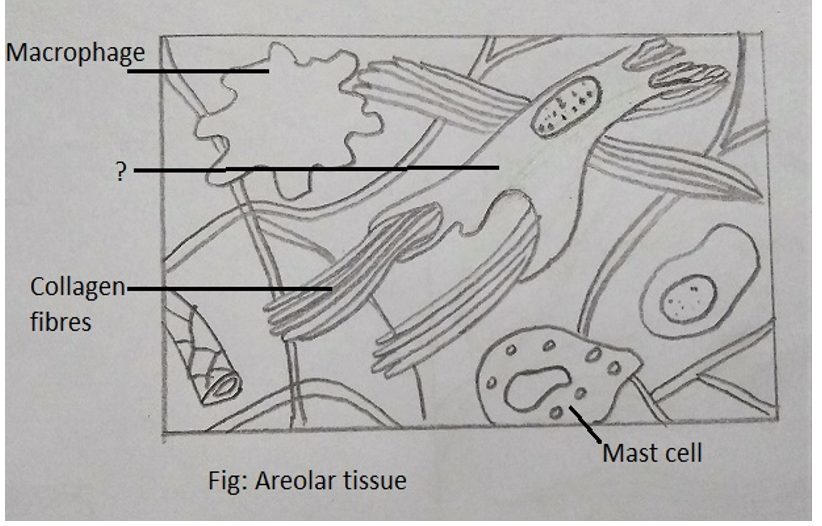
a) Mast cell
b) Fibroblast
c) Collagen fibres
d) Macrophage
View Answer
Explanation: The question mark in the given diagram represents a fibroblast which are cells that produce and secrete fibres. The diagram represents areolar tissue.
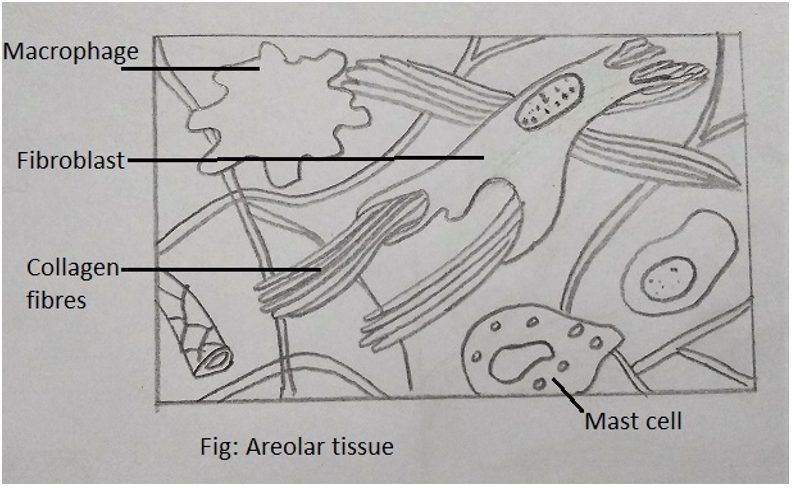
12. What is the name of the tissue given in the following figure?
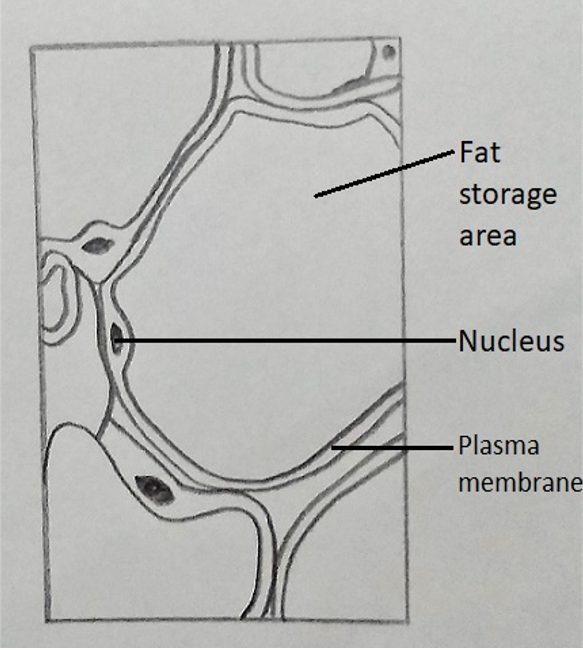
a) Areolar tissue
b) Adipose tissue
c) Bone
d) Cartilage
View Answer
Explanation: The given diagram represents an adipose tissue. It is located beneath the skin. The cells of this tissue are specialised to store fats. It also acts as an insulator by preventing the loss of heat from the body.
13. Areolar tissue is present beneath the skin.
a) True
b) False
View Answer
Explanation: Areolar tissue is present beneath the skin. It serves as a support framework for epithelium. It contains fibroblasts, macrophages and mast cells. It is a type of loose connective tissue.
14. What type of tissue does the following diagram represent?
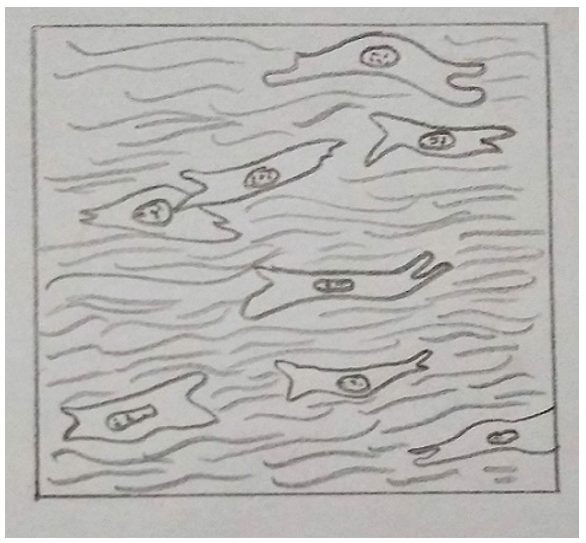
a) Dense regular
b) Dense irregular
c) Loose connective
d) Adipose tissue
View Answer
Explanation: The given figure represents dense regular connective tissue. In this type of tissue, the collagen fibres are present in rows between many parallel bundles of fibres. Tendons and ligaments are examples of this tissue.
15. What type of tissue does the given figure represent?
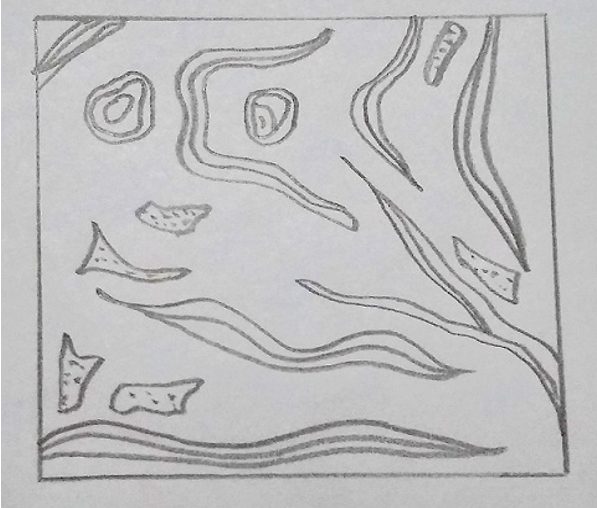
a) Dense regular
b) Areolar tissue
c) Dense irregular
d) Adipose
View Answer
Explanation: The given figure represents dense irregular connective tissue. It has fibroblasts and many fibres that are oriented differently. This tissue is present beneath the skin.
Sanfoundry Global Education & Learning Series – Biology – Class 11.
To practice all chapters and topics of Zoology, here is complete set of 1000+ Multiple Choice Questions and Answers.
If you find a mistake in question / option / answer, kindly take a screenshot and email to [email protected]
- Practice Class 11 - Physics MCQs
- Check Class 11 - Books
- Practice Class 11 - Chemistry MCQs
- Practice Class 11 - Mathematics MCQs
- Practice Class 12 - Biology MCQs
